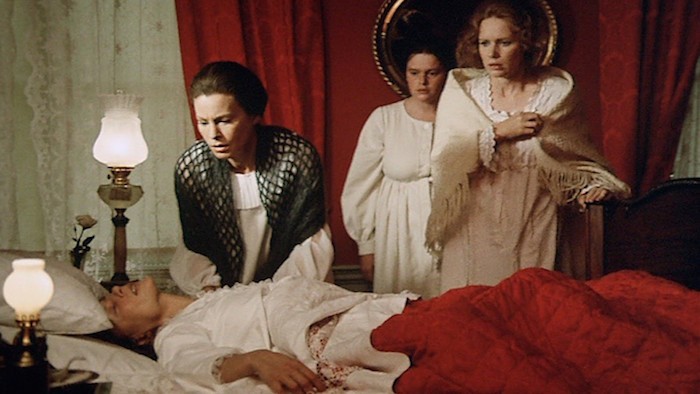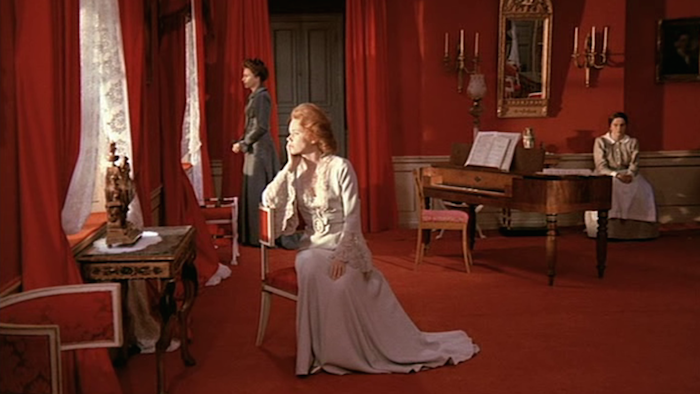The Influences Of 'The Witch' Part Three: Director Robert Eggers On 'Cries And Whispers'
With The Witch opening this week, we sat down with writer/director Robert Eggers to do something a little different. We asked him to name the three films that most influenced his tremendous new horror movie and we would discuss his work through the lens of what inspired him. In part one of this series, we talked about Stanley Kubrick's The Shining In part two, we chatted about Benjamin Christensen's Häxan: Witchcraft Through the Ages. For the third and final chapter in this series, we dove into Ingmar Bergman's gut-wrenching drama Cries and Whispers.
Every serious film fan must eventually dive into the filmography of the great Ingmar Bergman, the Swedish filmmaker whose work helped and shape and define the modern definition of cinematic drama. Over a career that lasted six decades and 67 directorial credits (including feature films documentaries, and television miniseries), Bergman used film to grapple with faith and loss, to explore religion as a root of suffering and a means of personal redemption. His work speaks volumes to so many people of so many different beliefs and backgrounds. It's telling that you can see echoes of his work in films of all genres, from filmmakers whose output doesn't bear an obvious connection to movies like The Seventh Seal and Wild Strawberries. Filmmakers as diverse as Stanley Kubrick, Steven Spielberg, Martin Scorsese, Woody Allen, Francis Ford Coppola, and Guillermo del Toro have noted his influence in their own views on cinema.
But yes, his work can be intimidating. Bergman is a filmmaker who stares into the abyss and his films can feel like a therapy session or a confession. Here is an artist using celluloid to cleanse his soul. Cries and Whispers is one of his more difficult films to watch and discuss because it is such a brutal experience, but it's easy to see how this exquisitely made but deeply uncomfortable chamber piece planted a few seeds in Robert Eggers that fully blossom during the course of The Witch.
Cries and Whispers establishes its premise quickly: a woman is dying and her sisters have come to attend to her in her final days. But she is in great pain and her death does not come quickly. Long-buried emotions rise to the surface. Flashbacks to events both joyous and melancholy feed us precious morsels of backstory. And in the film's supernaturally tinged final act, grief and jealously and cruelty and love all rise to the surface as every character is forced to confront their fear and loathing. The bonds of friendship and sisterhood are tested and broken. Through it all, Bergman tells their story with chilly precision, using shots that feel a little too long and close-ups that feel a little too close, to place you in uncomfortable proximity to so much raw agony. The costumes are black and white and grey, but the sets are invaded by red, a reminder of life in a sea of death.
You can see similar concepts at play in the more overtly genre chills of The Witch, a film that uses its horror premise to explore how the tiny lies and small betrayals that lurk under the surface of a family slowly tear them apart. You can't pick your family, so what happens when these people you're stuck with reveal that they may not have your best intentions at heart? That the person that is obligated to love you doesn't even like you, their affection more of a habit than a true feeling? The characters at the heart of The Witch desperately reach into their faith and pray to God to guide them, to heal them. The characters of Cries and Whispers don't even have that much – if there is a higher power, he abandoned them long ago.

The final portion of my conversation with Robert Eggers continues on the next page.
 I'll be perfectly honest. I always feel like a Bergman movie is going to be homework when I start watching it and I always end up getting pulled in quickly. Cries and Whispers is a great movie, but it may also be the least joyful movie ever made. It's not an easy sit.
I'll be perfectly honest. I always feel like a Bergman movie is going to be homework when I start watching it and I always end up getting pulled in quickly. Cries and Whispers is a great movie, but it may also be the least joyful movie ever made. It's not an easy sit.
[Laughs.] I just love Bergman so much. I just love him. I'm not saying I have this in my film, but Bergman's ability to have so much technical precision in a way that you're not aware of... You know, when you watch a Kubrick film, you're like "Nice, that shot is rad." But with Bergman, you're just watching the story unfold and you go back later you see that, oh my gosh, that was one very long, intensely choreographed shot. You're going from this person's subjective experience to this person's subjective experience, all in one shot. Wow. There is so much compassion for his characters in every single frame. That I really like.
The other thing about Cries and Whispers that is most directly influential [to The Witch] is the dream that isn't just a symbolic representation of plot stuff that we already know, but is actually moving the plot forward. It's utilized very well in Cries and Whispers and I pinched it heavily into The Witch. Bergman does this in Cries and Whispers and he does this in Hour of the Wolf and other films and other filmmakers do it too, but it's also what you don't see. I think there are reveals in my movie that are more alien, quick little flashes of things, but there's some stuff you literally don't see in Cries and Whispers and that you literally don't see in The Witch and that is sometimes better than eight frames of the monster.
All of Bergman's films deal with faith in a big way. Most of the time, like in Winter's Light or Through a Glass Darkly, they're about characters who have faith but struggle with it. Cries and Whispers feels like it's about people who wish they had faith and are incapable of having it. I feel like characters who embody both of those world views inhabit The Witch.
I have different religious views and/or problems than Bergman's views and/or problems, but I'm always struck by his films. Winter's Light is another film that I always watch and consider as a really great crisis. Sorry if that's a little vague...
[The publicist steps in to say this will be the final question.]
I was hoping we could touch on the women of Cries and Whispers and the women of The Witch, namely Thomasin and Katherine. Both films place their female characters in tragic situations in times and places when their needs aren't considered.
It was... yeah, man. Super important! [Laughs.] I could talk about Cries and Whispers and Victorian and Edwardian suppression all day and all night, but for The Witch, I'll just go to a stock statement that I say a lot. But it's very true. Thomasin is the most marginalized person in the microcosm of society that is this family. And even in the culture she would be the most marginalized person. Her strength and power that comes through is not just sexuality. It's not that simple. It's rubbing against the dogma. In the early modern period, the witch represented men's fears and ambivalences about female power and women's fears and ambivalences and their own power and motherhood in this male-dominated society. It's interesting to see, in a society that is trying to snuff out female power, how these kinds of weird explosions can happen.
Well, I look forward to seeing the movie again and I'm looking forward to seeing what you do with Nosferatu, if that's still on.
It's not next, even though that's all everyone wants to talk about! But thank you.
***
The Witch is in theaters February 19.
